Succulent Specialists Share Their Favourite Ways To Propagate New Aloe Plants

SUCCULENTS > ALOE > PROPAGATION

Elizabeth is a Permaculture Garden Designer, Sustainability Consultant and Professional Writer, working as an advocate for positive change. She graduated from the University of St. Andrews with an MA in English and Philosophy and obtained a Diploma in Applied Permaculture Design from the Permaculture Association.
Reviewed By PETER LICKORISH

Peter is a Horticulture Lecturer and self-employed Horticulturist, with a passion for diverse areas of the industry - from garden design to the science behind plant growth and propagation. He has completed the Royal Horticultural Society’s Master of Horticulture (MHort) Award and lectures on RHS courses at Bedford College.
Contributions From LES PEARCY

Les Pearcy is the Chairperson for The Haworthia Society and has been a member since its formation in 1986. The society focuses on the Aloaceae family and strives to find a better understanding of the plants in this genus, including Aloe. Les has been growing succulents for over 50 years.

With decades of experience growing cacti and succulents, David is the owner of Coach House Cacti, a specialist seller based in Dorset. He has won multiple Gold medals at various RHS Flower Shows throughout the years, with his achievements featured online. David is also a member of the British Cactus and Succulent Society.

Darren is the Plant Manager at Pugh's Cacti, a wholesale supplier of cactus and succulent plants to garden centres in the UK, based in Worcestershire.
ALOE GUIDES
Overwintering
Propagation
Varieties
Watering
Aloe vera plants are popular houseplants to grow in the UK and in other temperate climate areas far from their desert home.
If you already have an Aloe vera plant, you may be wondering how you can propagate it to obtain new plants for your home.
If you would like to grow more Aloe vera then there are three main propagation methods to consider:
- Sowing Aloe vera seeds in a heated propagator.
- Taking leaf cuttings of Aloe vera.
- Propagating Aloe vera from the offsets or pups that grow around the parent plant.
The third option is by far the easiest, but let’s take a look at all three of these options so that you can decide how you’d like to proceed.
| Difficulty | Easy to medium (depending on the method) |
| Equipment Required | Method 1: Aloe seeds, heated propagator, grow lights Method 2: Containers, sharp knife, suitable growing medium Method 3: Small pots, potting mix |
| When To Propagate | March to June |
1) Propagating By Seed
Growing Aloe vera from seed is not typically the option that will be chosen by most houseplant owners, since it is a little more challenging and time-consuming than the other methods listed below.
What’s more, you will typically need to have some extra equipment to be successful in getting the seeds to germinate.
You will usually require a heated propagator to provide the consistent heat needed for successful germination and you may also need some grow lights in order to provide the plants with the light that they require, as the seeds typically need 8-10 hours of sunlight for germination to take place.

If you want to grow Aloe vera from seed, it is also important to note that aloe cross-pollinates easily and that seeds from many named cultivars will not necessarily grow into plants that look just like their parent.
If you do decide to proceed with propagating Aloe vera in this way, sow seeds into a suitable seed-starting growing medium for succulent plants and the seeds should germinate in a heated propagator at 23°C within 2-4 weeks.
However, their erratic germination means more may suddenly appear many weeks later.
Remember, young plants will grow slowly and will take a long while to become plants that are of a more impressive size, which Darren Evans, Plant Manager at Pugh’s Cacti, deems as rewarding:
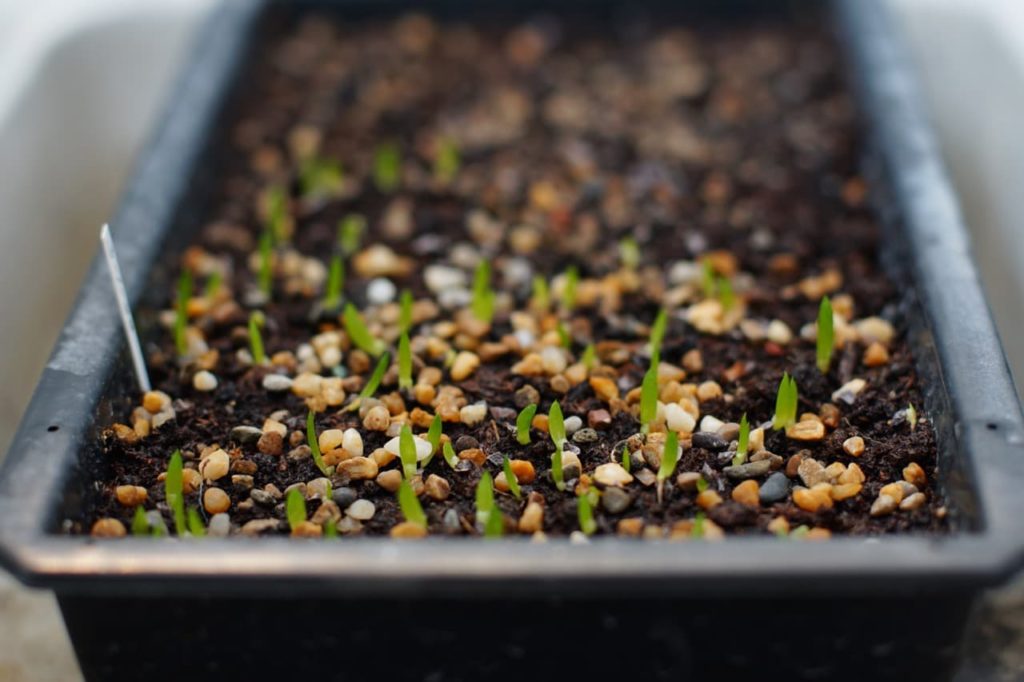
“Growing a cactus or succulent from seed is so rewarding, as seeing a small seedling appear that looks completely different to other seedlings is a joy,” he says.
“The seedling can take 12 months to grow which only increases the anticipation and excitement of growing your own.”
You will need to mollycoddle them and gradually move them on individually into increasingly larger pots until they become larger and more established plants.
2) Propagating Via Leaf Cuttings
The next option that you might consider if you want to obtain new Aloe vera plants from your existing ones is propagation by leaf cuttings.
It is best to use a few of the fully developed leaves from around the outside of the plant for your cuttings, avoiding any which are browning, and to take several at once because the results can be variable.
With a few cuttings, you will have the best chance to obtain new plants and get the cuttings to root successfully.
“Variegation can be less stable with leaf cuttings, but aim for a leaf that is of the colouring you desire,” shares Master Horticulturist Peter Lickorish.
Use a sharp, clean knife and cut off the outer leaves that you have selected to use as leaf cuttings.
It is best to cut as close to the main stem as possible.

The best time to take these leaf cuttings is in the spring, around March or April.
Take your leaf cuttings and leave them in a warm place for a few days.
This allows the wound to dry and lets a callus form on the surface where the leaf was cut.
“Always dry off any cutting or offset by placing the wound into direct sunlight until a callous has formed,” shares David Ennals from Coach House Cacti.
If you do not allow a callus to form, there is a much higher likelihood that the leaf will rot rather than root successfully.

Prepare a pot, filled with a suitable growing medium.
A mixture of one-part multipurpose potting mix to one-part sand or a dedicated succulent potting mix will provide the necessary conditions for the best chance of Aloe vera cuttings rooting successfully.
Make sure that the growing medium is moist but not saturated and that excess water can drain away freely at the base of the container you are using.
Take the Aloe vera leaf once the callus has formed on the cut end and lay it sideways in the soil so that around two-thirds of the leaf is visible.
You can rest the tip away from the cut end on the side of the pot, so the whole leaf is slightly diagonal, to reduce the risk of the leaf rotting.
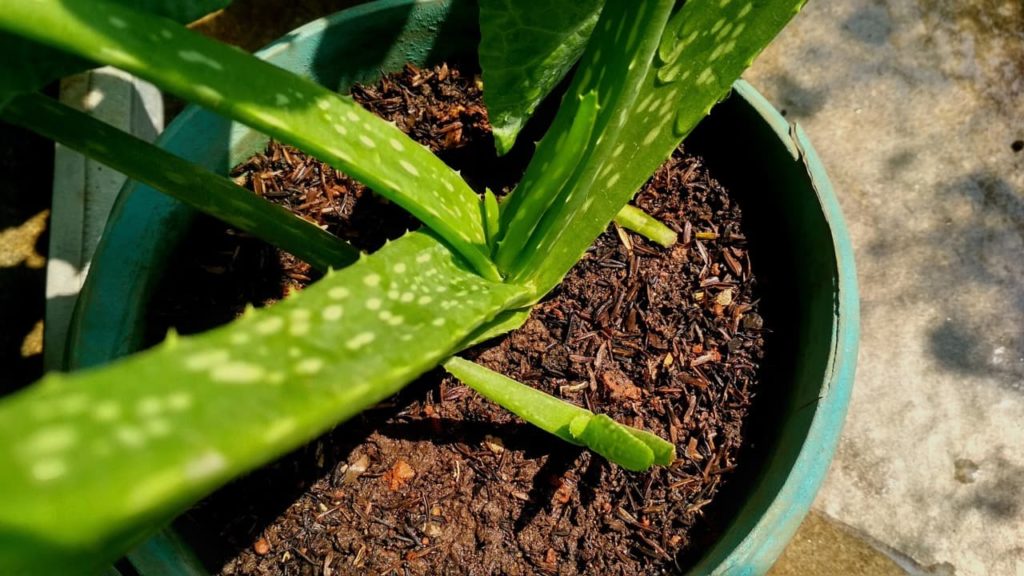
“Place the cutting in free-draining compost to a depth of 1-2 cm, as the cut end must receive oxygen,” says David.
“Water initially then sparingly until roots form.”
Place the pot with this leaf in a warm, sunny location and maintain moisture in the growing medium.
After around 4 weeks, new roots should have developed from the leaf and you should have a new plant that can be tended to as you would tend your other Aloe vera specimens.
3) Propagating From Offsets
While either of the above options can be successful, by far the easiest and most effective way to obtain new Aloe vera plants from an existing one is to separate and pot up the offsets that form around the base of a mature plant.
“Many plants form offsets, which often have roots attached and can be easily separated from the main plant,” says Les Pearcy, Chairperson of The Haworthia Society.
“Leaves and stems on many succulents can be cut from the stem with a sharp knife. It is very important to allow the cut surfaces to dry for about a week before planting.”
You can take the Aloe vera offsets from a parent plant while they are still very small but, for best results, it is a good idea to wait until they reach a reasonable size to stand on their own.
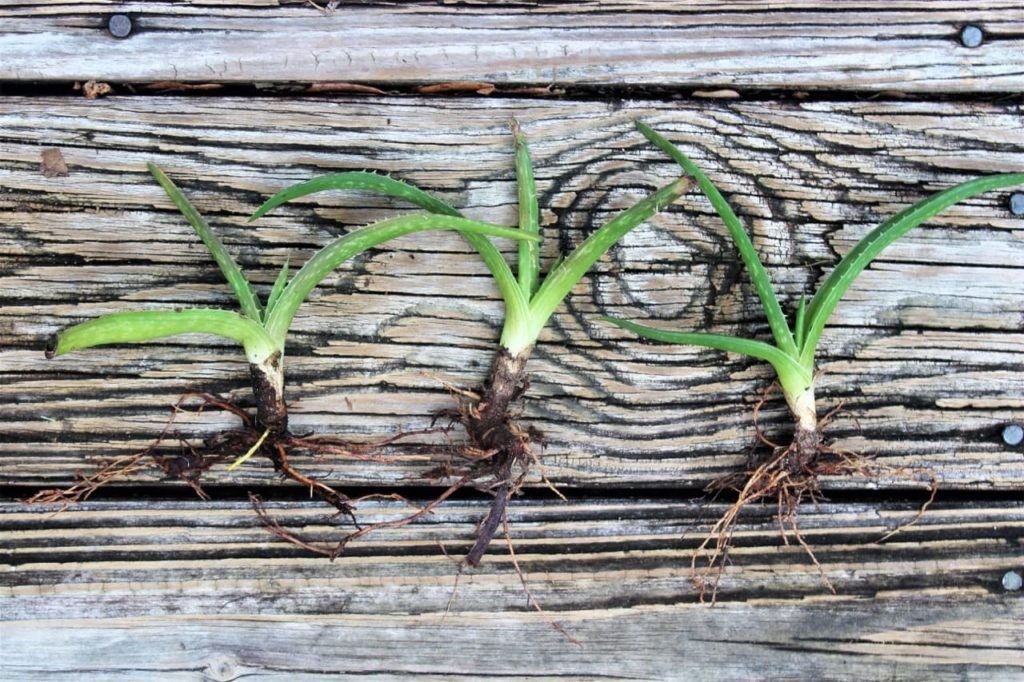
Taking the offsets when they are around 20% of the dimensions of the parent plant is generally the best policy.
The easiest way to separate the pups from the parent Aloe vera plant is to lift the entire plant from its current container.
Take a look at the offsets.
Sometimes, these will already have formed their own roots and you should try to sever these pups from the parent plant with some roots attached.
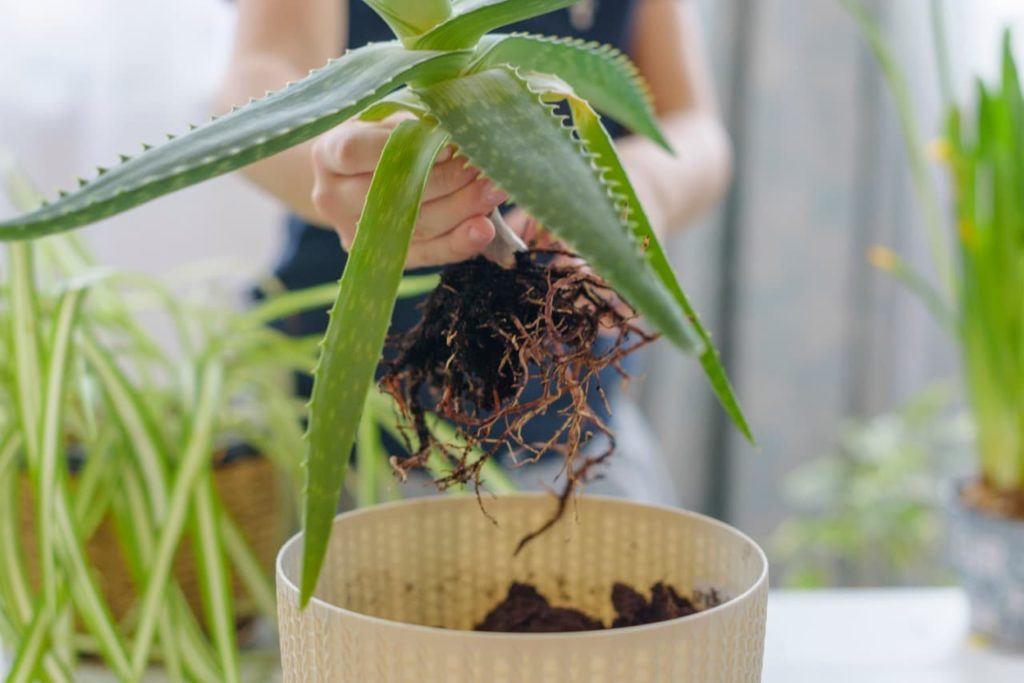
You may be able to separate the offsets by hand, but in some cases, you might have to use a sharp, clean knife to separate them.
If offsets have already rooted, these can be potted up right away into their own containers.
Pot up each of the offsets, making sure you are placing them into a suitable free-draining multipurpose peat-free potting mix.
If the offsets do not have their own roots, allow the nub at the base of the offsets you have separated from the parent plant to dry out and callus over as you do with leaf cuttings.
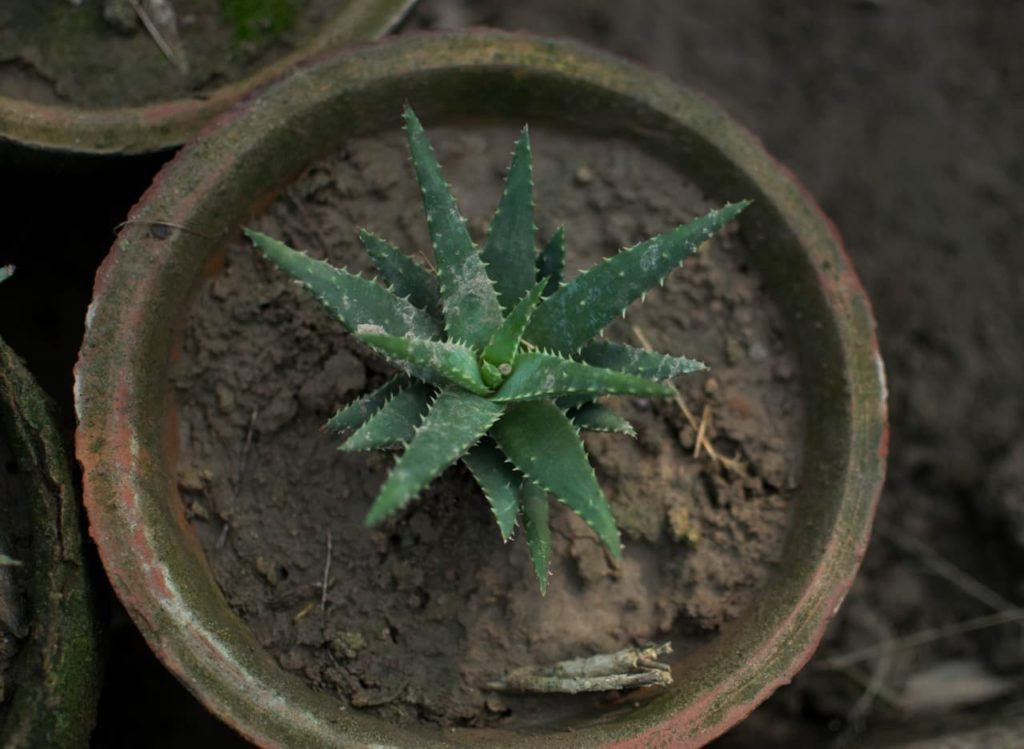
Afterwards, pot up as above and wait for the roots to form, which should occur in a matter of weeks.
Once you have potted up the offsets, make sure that you water them in well but allow excess water to drain away freely.
The bottom of the stalk is prone to rot or become infected if replanted straight away, so leave it out to dry for a few days – you should notice a rough callous forming at the site of the cut.
“It is best to wait for roots to form before watering, but spraying with water can help speed up the rooting process,” adds Les.
Care for your young Aloe vera as you would for any other more mature Aloe vera plant.
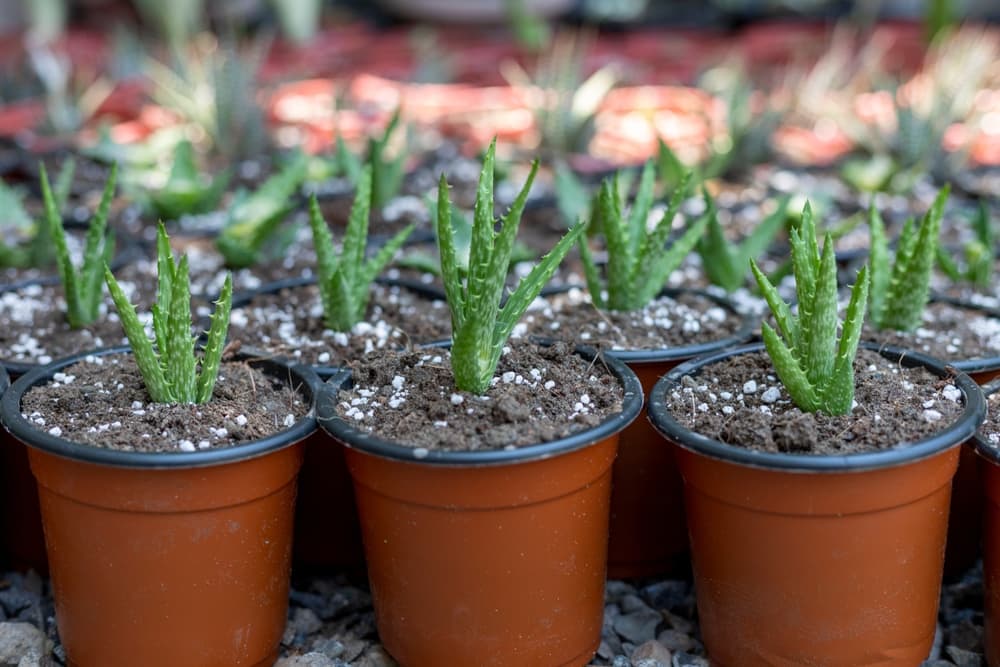
Planting up the offsets from an existing Aloe vera plant is by far the easiest way to obtain new plants that look like their parent plant.
“With divisions, what you see is what you get,” says Peter.
“It’s important to select growth showing the correct colour or variegation if your plant is one of the many unusual Aloe cultivars. “
